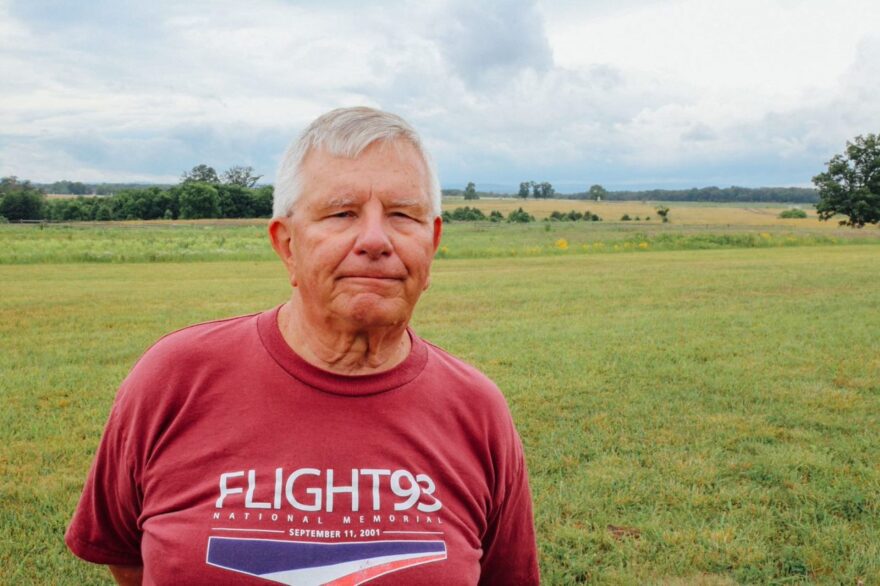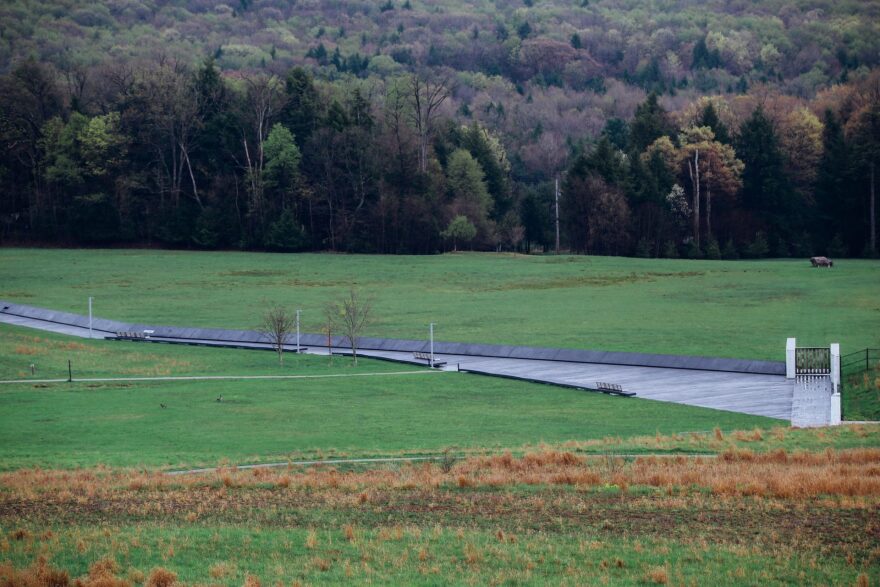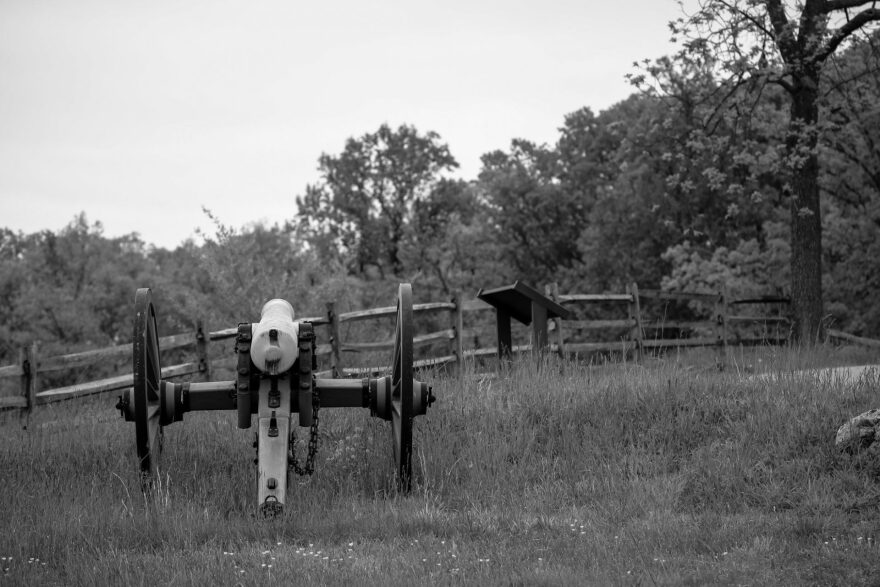If you travel along Route 30 in southern Pennsylvania, about 105 miles separates two places of immense historical significance.
One is where the bloodiest battle of the Civil War was fought.
The other is where the last of the four hijacked jetliners crashed during the Sept. 11 attacks.
While each is the scene of horror and heartbreak, they have come to represent sacrifice and bravery of the highest order.
As the nation prepares to mark the 20th anniversary of the Sept. 11, 2001, terrorist attacks, many vacationers may have plans to visit these two very different sites. What they will find is how the Gettysburg battlefield and the Flight 93 National Memorial honor shining moments amid two dark periods in American history.
On July 1, 158 years to the day the desperate fight began to the northwest of Gettysburg, about a dozen people were milling around the area known as the Angle at the Gettysburg National Military Park, where U.S. troops turned back Pickett’s Charge.
A couple of tour guides pass each other as they take their small groups through the history of this hallowed ground.
“Hey, John!”
“Hey, George. Haven’t seen you in a while.”
There’s no small talk. They have jobs to do — helping their customers better understand one of the most crucial battles of the Civil War.

After three days of fighting, an estimated 10,000 soldiers were killed or mortally wounded, another 30,000 were wounded, and 10,000 were captured or missing. The battle has been described as the bloodiest of the conflict.
Not far from this spot — just off the center of the Union line — 74-year-old Ed Root is looking up at the monument to the First Minnesota, a unit that epitomizes courage in the face of overwhelming odds.
On the second day of the clash, Union forces were about to crack and allow a breakthrough by determined Confederate troops. When General Winfield Scott Hancock looked around for reinforcements, he yelled to the first soldiers he saw.
“The First Minnesota was thrown into the gap by General Hancock. And they suffered grievous casualties on that day, something like 80 percent, historians say,” said Ed Root, a history buff. “If they had not blunted that attack, it becomes, the ‘what ifs’ … what would have happened if they weren’t here to begin with, or if they hadn’t blunted that attack, and how that may or may not have changed the the outcome of the battle.”
The unit held just long enough for other U.S. troops to arrive and halt the surge. But, more than 224 First Minnesotans were killed or wounded out of 335 who made the charge. The carnage led to what’s believed to be the highest casualty rate suffered by a Union regiment during a single action of the war.
“So it’s another one of those great moments of history that people still argue about today, as far as what the role was, and what could happen, what should have happened, what might have happened if if they didn’t do what they did,” he said.

Root, who lives in Bethlehem, has made countless trips to Gettysburg over the years.
He also has a personal connection to another battle in Pennsylvania — one fought in the skies above southwestern Pennsylvania on Sept. 11, 2001. His first cousin was Lorraine Bay. She was a flight attendant on United Airlines Flight 93, which crashed near Shanksville, Somerset County, during the terrorist attacks.
Root and his wife were flying home from England that day in September, when their plane was turned around and sent back to London. They were set up in a hotel, and tried to piece together what had unfolded in their home country.
His first concern was for his son, Derek, who worked in Midtown Manhattan. Where Lorraine was didn’t really cross his mind, because she was nearing retirement and wasn’t flying as frequently.
Then, he called back his 25-year-old daughter Emily for the latest information, when she broke the horrible news to him.
“I was sitting at a little desk in the hotel room and my wife was sitting on the other side of the room in the chair when Emily told me and I repeated it,” he said “And my wife said, kind of like ‘Lorraine?’”
“I was just hoping against hope that there was some kind of other news that was going to come out of this and I just looked at her and said, ‘No,'” he recalled.
Flight 93 is the only one of the four hijacked jetliners to fail to reach its target — believed to be the U.S. Capitol.

Benefitting from a 25-minute delay from their scheduled takeoff, 13 passengers and crew members were able to make 37 phone calls.
The 40 passengers and crew gained precious intelligence about the three other aircrafts that plunged into the World Trade Center towers in New York and the Pentagon in Virginia.
They told their loved ones they had voted to try to overtake the four terrorists and seize control of the jet. They then stormed the cockpit.
United 93 crashed in a field in Stonycreek Township.
While Root has only been able to view the Battle of Gettysburg through the lens of history, he’s played an active role in determining how the story of the Heroes of Flight 93 — as they are known — will be told to future generations.
“I mean, one of the most moving things to me is when the young lady [Honor Elizabeth Wainio] talking to her mother said, ‘I have to go now, Mom, everyone’s going up front.’ I mean, to me, that is just so powerful,” he said.

Shanksville.
Gettysburg.
The mere mention of the two small Pennsylvania communities can instantly take you to photos of a charred crater or a Wall of Names, bayonet charges and smoke from cannon and musket fire.
Or, it can lead to introspection.
You may envision yourself on that plane or in that line of fire and let your mind wonder.
“Who knows what they thought their chances were of coming out of this alive. I would think that those 40 people wanted to live. I don’t think it was for them a suicide mission that, ‘OK, we know we’re going to die and we’re going to do this, just because we have to save the world,’” Root said. “I think they knew the consequences if they didn’t do something. I believe that they hoped against hope that they thought they could do both.”
In the summer of 2002, Miami Herald columnist Dave Barry walked the grounds of each site, including the debris-strewn fields and woods of the Flight 93 crash site.
One thought kept creeping into his mind.
“In both cases, two places that had no reason to exist as historic cemeteries, became those things … just out of sheer most random chance,” Barry said. “Gettysburg was pretty random. But, nothing could be more random than what happened in Somerset County … in that field.”
So, he put his thoughts into words — basically “waxing philosophically,” as he puts it — on how a pair of horrible events transformed these two rural areas.

His central theme of the column — On Hallowed Ground — focused on finding the proper balance between reverence and respect and tourism and commercialization.
As the 20th anniversary nears, he sees how the distance of time is affecting how the nation views that day in September 2001.
“It just feels like the process of transforming something from an immediate, real, painful thing into an historic, sad — but not personally sad — event that has happened in Gettysburg, seems to be happening with 9/11,” he said.
Back at the First Minnesota monument in Gettysburg, Ed Root agrees the story of Flight 93 faces a big challenge to reach and resonate with younger people who didn’t experience the Sept. 11 attacks in real time.
To him, how different generations view major events in the country’s history could be described as “us and them.”
“When you experience an event, whether it had been Pearl Harbor or the Kennedy assassination or Gettysburg, or the events of 9/11, the people who lived through it, it happened to ‘us.’ Even if you weren’t personally involved anywhere in this country, that’s the way they felt,” he said. “It happened to us.”
“As time goes by, the danger is that it’s no longer personal anymore. And if you look at Pearl Harbor, now, when the anniversary comes up as something that … it happened to ‘them,'” he added. “People, in large part, have lost that feeling of the ‘us.’ And I think that’s the challenge of Flight 93 to make people or try to make people understand how those of us who lived through it felt, reacted, believed.”
“Flight 93, as we see after 20 years, people who didn’t experience it personally, they’re still coming. So, that’s a good sign it’s not going to die away with the people who lived through it,” Root said. “It’s going to be something that will be passed on to generation after generation — which is where we are at Gettysburg.”

When looking at the Union line formed along the ridges, fields and rolling hills at Gettysburg, it is best described as a fish hook.
On the far right — the fish hook as it were — looms Culp’s Hill.
At its base, near Spangler’s Spring, stands another person with a unique perspective on what binds Gettysburg and Flight 93 to the nation’s collective consciousness.
Jason Martz, a spokesman at the Gettysburg National Military Park, was born in Somerset, not far from Shanksville. He still has some extended family who live in the Shanksville area. Professionally, he has also worked at the Flight 93 National Memorial as one of their public information officers during the annual Sept. 11 commemoration events.
His connection goes just a little deeper.
His mom is Susan Hankinson, who was Somerset County’s Flight 93 coordinator and family liaison for four years.
“It helped bring the Flight 93 story very close to me, even before I was associated with it through the National Park Service,” he said.
Martz was living in Gettysburg in 2001 and struggled to comprehend how the Shanksville area had become a part of the largest terrorist attack on U.S. soil.
The Twin Towers made sense to him.
So, did the Pentagon.
“But the fact this plane went down in the middle of a reclaimed strip mine, I still couldn’t get my head wrapped around it. That was the one of the four that was able to thwart the ultimate goal of the terrorists,” he said. “That was to wreck the financial, wreck the government, wreck the military to its core.”
“I think it speaks to how just any random collection of people who don’t know each other, on a random flight from point A to point B can in hindsight, anyway, be able to come together in such a way that alters the history of this country,” he said.
Think about that last phrase.
“Alters the history of the country.”
Over the course of three days, the brutal fighting at Gettysburg did that — halting the Confederate invasion of the North and easing the threat on Washington, D.C.
Coupled with the U.S. victory in Vicksburg, Mississippi, a day later, the country finally felt a bit of optimism after a string of disappointing defeats at places like Fredericksburg and Chancellorsville.
But that impact perhaps wasn’t fully realized until President Abraham Lincoln delivered his Gettysburg Address the following November.

It’s a little more nuanced for Flight 93, since its story is often portrayed like a footnote in the story of 9/11.
Over the course of less than 40 minutes, the passengers and crew gathered intelligence and were able to thwart the terrorists’ plans.
The 757 crashes at 10:03 a.m.
When word of their phone calls and bravery begins to emerge, a wounded nation is provided with a bright light amid a psychologically devastating day.
But when that day is discussed nearly 20 years later, it’s often described as an attack on New York and Washington — and included a fourth plane that crashed in a Pennsylvania field.
“I think it really comes down to at this stage, whether it’s 20 years ago, or 158 years ago, it’s remembering those who participated, remembering those who fell, remembering those who fought for whatever it was that they believed in,” Martz said.
“How could they possibly know that what they were going to do? They would ultimately end their lives in the ultimate sacrifice. We’ll never know. But could it could be one of the most resounding impacts in American history,” he added.
People are drawn to these towering, nearly incomprehensible events. Events they know are important and changed history’s trajectory.
When they make their way around, they see the First Minnesota monument, or read about flight attendant Sandy Bradshaw’s phone call to her husband, it all becomes real, and personal.
They may see themselves reflected in what happened. That is the magic that happens at places like this.
“They are certain things that just have their own standing, things like Gettysburg, things like September 11, things like D-Day, things like Pearl Harbor, and on and on and on. There are these singular singular days in the the history of the United States that have no comparison,” Martz said. “I think Flight 93 and Gettysburg are in that small group of events that have occurred over the history of this country that have no equals.”

A few more cars are stopping not far from us. Tourists get out, stretch their legs, maybe snap a picture or two, and read the plaques explaining the significance of where they are standing
Then, they slowly drive along the winding roads to the top of Culp’s Hill.
Martz glances their way and reflects a bit on a nearly 40-minute conversation.
“These are heavy, heavy places to be. And it’s a very difficult thing to compare and contrast, even though there are a lot of similar themes. The sacrifices that were made at places like on Civil War, battlefields like Gettysburg, and the sacrifice that was made by those who were on Flight 93 are things that most normal people, myself included, really can’t ever possibly fathom,” he said. “It’s up to us to attempt to tell their stories in the best way that we can so that their actions are never forgotten.”
In 1889, an elderly Joshua Chamberlain — the hero of Little Round Top — spoke at the dedication of the 20th Maine Monument on the southern end of the Union fish hook.
His words are uncanny in how they capture what continually draws people to places that helped stitch the fabric of the nation together for the last 245 years:
“In great deeds something abides. On great fields something stays. Forms change and pass; bodies disappear, but spirits linger, to consecrate ground for the vision-place of souls. And reverent men and women from afar, and generations that know us not and that we know not of, heart-drawn to see where and by whom great things were suffered and done for them, shall come to this deathless field to ponder and dream; And lo! the shadow of a mighty presence shall wrap them in its bosom, and the power of the vision pass into their souls.”
The passage of time brings more and more distance from the extraordinary acts carried out in the rolling fields of Gettysburg and the sparkling blue skies above Shanksville.
But people continue to find their way to these out-of-the-way places.
Last year, with the coronavirus pandemic raging, more than 500,000 people visited the Gettysburg battlefield, and nearly 250,000 traveled to the Flight 93 National Memorial.
They come to these sites where heroic actions changed the fate of the nation — to see for themselves, feel for themselves, imagine for themselves.
They might even ask: Would I have done what they did? Could I?

Read more from our partners, WITF.




